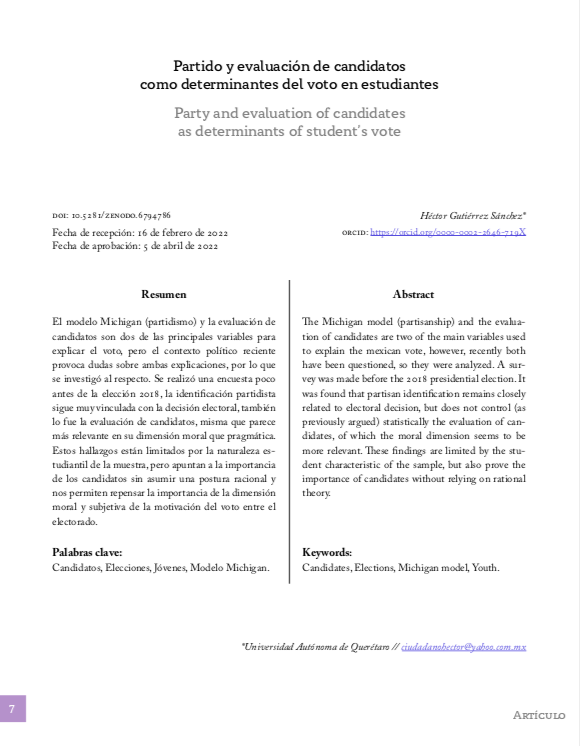Abstract
The Michigan model (partisanship) and the evaluation of candidates are two of the main variables used to explain the Mexican vote, however, recently both have been questioned, so they were analyzed. A survey was made before the 2018 presidential election. It was found that partisan identification remains closely related to electoral decision, but does not control (as previously argued) statistically the evaluation of candidates, of which the moral dimension seems to be more relevant. These findings are limited by the student characteristic of the sample, but also prove the importance of candidates without relying on rational theory.
References
Blais, A., Gidengil, E., Nadeau, R. & Nevitte, N. (2001, marzo). “Measuring Party Identification: Britain, Canada, and the United States”. Political Behavior, 23(1), 5-22.
Campbell, A., Converse, P., Stokes, D. & Warren, M. (1960). The American Voter. The University of Chicago Press.
Gómez, S. & Valdés, M. (2000). La geografía del poder. Plaza y Valdés.
Gómez, S. (2009). ¿Cuántos votos necesita la democracia? Instituto Federal Electoral.
Greene, K, F. & Sánchez-Talanquer, M. (2018). Authoritarian legacies and party system stability in Mexico. Cambridge University Press.
Guardado, J. (2009). “La identidad partidista en México. Las dimensiones políticas de la competencia en las elecciones presidenciales de 2000 y 2006”. Política y Gobierno, (1), 137-175.
Gutiérrez, H. (2019). “La demanda moral hacia los políticos”. Espiral, 28(76), 233-272.
Kuschick, M. (2012). “Pronóstico electoral para el Distrito Federal en la elección de 2012”. Mexicana de Opinión Pública, (12), 127-145.
Malanchuk, O., Miller, A. & Wattenberg, M. (1986). “Schematic Assessments of Presidential Candidate”. Political Science Publications, 2(80), 521-540.
Moreno, A. (2009). La decisión electoral. Votantes, partidos y democracia en México. México. Porrúa.
Moreno, A. (2018). El cambio electoral. Votantes, encuestas y democracia en México, México. Fondo de Cultura Económica.
Rodríguez, A. (13 de agosto de 2019). “Para el servicio público se necesita 99% de honestidad y 1% de capacidad, dice amlo”. Proceso. https://www.proceso.com.mx/595958/pa-ra-el-servicio-publico-se-necesita-99-de-honestidad-y-1-de-capacidad-dice-amlo
Rusell, J. D. (1984). “Cognitive Mobilization and partisan Dealignment in Advanced industrial democracies”. Journal of politics, 46(1), 264-284.
Sartori, G. (1980). Partidos y sistemas de partidos. Alianza editorial.

This work is licensed under a Creative Commons Attribution-NonCommercial-ShareAlike 4.0 International License.
Copyright (c) 2022 ALBORES


